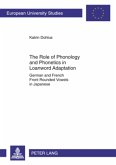This popular and accessible introduction to phonetics has been fully updated for its third edition, and now includes an accompanying website with sound files, and expanded coverage of topics such as speech technology.
Describes how languages use a variety of different sounds, many of them quite unlike any that occur in well-known languages
Written by the late Peter Ladefoged, one of the world's leading phoneticians, with updates by renowned forensic linguist, Sandra Ferrari Disner
Includes numerous revisions to the discussion of speech technology and additional updates throughout the book
Explores the acoustic, articulatory, and perceptual components of speech, demonstrates speech synthesis, and explains how speech recognition systems work
Will be supported by a forthcoming accompanying website featuring additional data and recordings of the sounds of a wide variety of languages, to reinforce learning and bring the descriptions to life
Hinweis: Dieser Artikel kann nur an eine deutsche Lieferadresse ausgeliefert werden.
Describes how languages use a variety of different sounds, many of them quite unlike any that occur in well-known languages
Written by the late Peter Ladefoged, one of the world's leading phoneticians, with updates by renowned forensic linguist, Sandra Ferrari Disner
Includes numerous revisions to the discussion of speech technology and additional updates throughout the book
Explores the acoustic, articulatory, and perceptual components of speech, demonstrates speech synthesis, and explains how speech recognition systems work
Will be supported by a forthcoming accompanying website featuring additional data and recordings of the sounds of a wide variety of languages, to reinforce learning and bring the descriptions to life
Hinweis: Dieser Artikel kann nur an eine deutsche Lieferadresse ausgeliefert werden.








